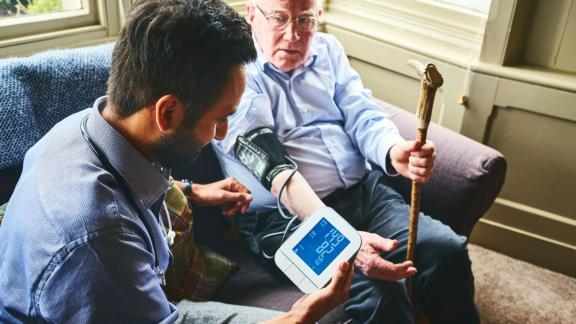Getting frailty patients home earlier: virtual wards in North West Anglia

Eligible frail patients who would otherwise have needed to be kept in hospital are being supported at home by a multidisciplinary team. This is reducing their length of stay in hospital or avoiding the need for hospitalisation altogether, but ensures they get the same standard of care at home. Cambridge and Peterborough Integrated Care System (ICS) has funded the Greater Peterborough Network, a federation of over 20 GP practices, and the North West Anglia Foundation Trust to run the service.
Key benefits and outcomes
- Length of hospital stays has reduced without any impact on readmission rates.
- Patients are at lower risk of deconditioning if they are cared for in their own home.
- Although the project is not aimed at saving money, it has freed hospital beds for those who can only be cared for in hospital.
What the organisation faced
Like any health economy, Peterborough has areas of pressure – specifically around bed availability –and a very busy urgent and emergency care service. Running alongside this is a need to limit the length of stay for frail patients, who are at risk of deconditioning with long hospitals stays. These patients could potentially be identified at an early stage while they were still in A&E and, instead of being hospitalised, could be looked after at home with added social care support and input from primary care.
What the organisation did
A frailty virtual ward model was launched in December 2022, funded by the ICS, starting with lower acuity patients and with the intention of then spreading to those with greater needs. The aim was to offer something which was a true hospital at home – taking patients who would not normally have been considered suitable for discharge into the community. The support offered is individual to each patient and can include doctor input, physiotherapists and occupational therapists, with an assessment done in the home. The team holds daily ‘ward rounds’ which involve hospital consultants to consider the patients’ progress, using information about their NEWS scores and other indicators. There is no fixed limit for the time patients can spend under the care of the virtual ward although around six days is the average.
The team will also look at any other condition the patients have – other than the immediate reason for admission – and will try to bring them under control in this time.
When patients no longer need to be in the virtual ward, they can be discharged back to the care of their GP and community nurses.
Shared information between the frailty team and general practice team was important to allow everyone to see the same information on the patient on single system.
Results and benefits
Of the first 64 patients referred to the scheme, just eight were thought to be better off remaining in hospital. Those treated at home spent an average of 5.8 days on the virtual ward – time which would otherwise have been in hospital. Readmission rates have been in line with the in-hospital frailty ward at about 20 per cent.
Feedback from patients and their carers has generally been very positive. Only one patient did not want to join the pilot and elected to stay in hospital instead.
Overcoming obstacles
The original plan was to make greater use of technology than the teams have eventually done. With a very elderly frail cohort, many would not be comfortable with video calls or collecting and entering their own physiological information, for example. However, technology such as behavioural sensors are being looked at – falls are frequent in this cohort and could be picked up by sensors, without the individual having to do anything.
Many patients need social care as well as healthcare. Their packages of care can be paused while they are in hospital and there can be a gap before they are reactivated. Working with the local authority, an enhanced recovery service has been put in place which can fill this gap in the short term.
Another challenge has been stopping the initiative being seen as a way to close beds and save money. The number of beds are not reduced as, due to heavy demand, any beds vacated in the hospital are immediately filled. The service is in fact an additional cost and will need to be given additional funding to ensure it can continue.
Takeaway tips
- Clinician buy-in and understanding of what can and can’t be offered by the virtual frailty ward is vital.
- Supporting these patients at home requires a different mindset and skillset from staff – some may be nervous or even reluctant to engage initially.
- A swift escalation process and pathways back into hospital should a patient deteriorate or fail to make the progress expected is very important.
- Trust and communication between partners is vital but has to be built over time.
Further information
For more information please contact Kim.ashall@nhs.net or Helen.lord7@nhs.net.



